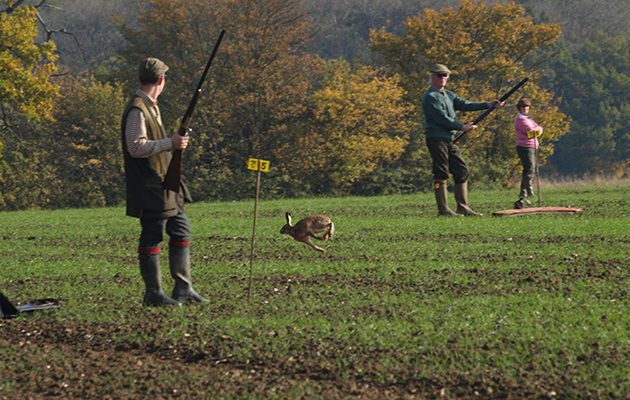Getting a gundog steady to game is, perhaps, the greatest challenge facing an amateur dog handler, says David Tomlinson. So how do you deliver them from evil doing?
Learning how to get a gundog steady to game is one of the greatest challenges for amateur dog handlers. David Tomlinson offers his advice on hares, deer, sheep and everything else so irresistible to gundogs.
For more advice on training the perfect peg dog or picker up, following these 9 gundog training tips from The Field.
HOW TO GET A GUNDOG STEADY TO GAME
I freely admit that my first springer spaniel taught me far more than I ever succeeded in teaching her. She was a handsome tri-colour, a rarity in working springers, with a passion for hunting and an obsession with pheasants. Even from her early puppyhood she was fascinated with the long-tailed birds. I had a theory that when her nose was full of scent her ears stopped working, as she always ignored the stop whistle when hunting pheasants.
Part of the problem was that she was a once-a-fortnight shooting dog and, as such, was determined to make the most of every hunting opportunity that came her way. I belonged to a small, walk-one, stand-one syndicate but I rarely stood, as my dog was much happier hunting. Fortunately, the brambles were thick enough to slow her down but if she got a clear view of a departing pheasant she would cheerfully set off in pursuit.
Succeeding spaniels from the same line showed the same enthusiasm for pheasants: it was something they were born with. It wasn’t until I moved to Suffolk, to a house surrounded by pheasants, that my spaniels at last became relaxed about them, happy to nose them up and watch them fly away. Familiarity breeds contempt.
Getting a gundog steady to game is arguably the biggest challenge facing any amateur gundog handler. Some years ago I went to a gundog test, organised by BASC, in which the open was won convincingly by a fast and stylish black labrador. I congratulated the dog’s owner afterwards and was surprised to learn that his dog was a test specialist, as it became far too excited on a proper shooting day to be let off a lead. It’s worth adding that the dog’s owner was a keen shooting man, greatly frustrated to have such an accomplished dog that couldn’t go shooting.
While game in general was this dog’s failing, I’ve met plenty of other top-class gundogs that would, on rare occasions, succumb to temptation. Hares are probably the greatest temptresses of all, especially for dogs that don’t encounter them very often. On a driven day hares have a habit of galloping through the line. There’s usually a no-ground-game rule, so the hares are safe from being shot – if not from pursuing dogs. It’s remarkable how easily a dog can pull out its tethering corkscrew under such circumstances.
I’ve never seen a brown hare caught on a driven day, though I have observed some long and exciting chases. One of the most memorable courses I’ve ever watched was during a pointer field trial near Newmarket. The dog in question wasn’t a novice with an inexperienced handler but a past winner of the Champion Stake, the highest award for pointers and setters. Dogs are great levellers.
If you have ever picked up on a grouse moor with a high population of blue or mountain hares you will be well aware that Lepus timidus has neither the speed nor the endurance of its brown lowland cousins. Even a moderately fit cocker spaniel is in with a chance of catching a blue hare and once they have discovered how easy it is to catch one they are keen to do it again. The keepers’ dogs and those of the local pickers-up usually ignore them but dogs that wouldn’t dream of chasing a rabbit at home in Berkshire often find Berwick hares simply irresistible.
Deer also provide a great test of steadiness and, today, the ever-expanding deer population means that there are few shoots with no deer. Red, fallow and roe are all sufficiently fast and powerful to get out of trouble quickly but not so the muntjac. These small deer are often surprisingly bold and approachable – and catchable by a powerful dog. I’ve met a German wirehaired pointer that was a muntjac specialist, while I have also seen a big springer successfully pull one down. On one memorable occasion, while rough shooting in Northamptonshire, one of my spaniels retrieved a baby muntjac while her daughter chased the unfortunate mother. Neither dog had encountered a muntjac before.
Steadiness to domestic stock is essential with a working gundog. I once had a spaniel that was walked as a puppy through a flock of sheep every day, never showing the slightest interest in them. On her first visit to Exmoor she chased a sheep. Fortunately no harm was done and she never pursued another one, but it was a reminder that there’s a lot of difference, at least to a dog, between a lowland sheep and one on the hill.
Chickens can also be irresistible. I have a small flock of free-range hens that are ignored by my dogs but there have been disasters with visitors’ dogs. On one occasion a professional gundog trainer came to lunch, leaving his dogs in the back of his pick-up truck where they sat for an hour, watching my hens. When they were let out they were after the chickens as quick as a flash. Their handler, who had assured me his dogs were steady to birds, was deservedly red faced.
Frustratingly, there’s no magic technique to make a dog steady. Some dogs never chase anything but others remain subject to temptation throughout their lives. In my experience, familiarity is the best cure – but achieving that can be a challenge in itself.





